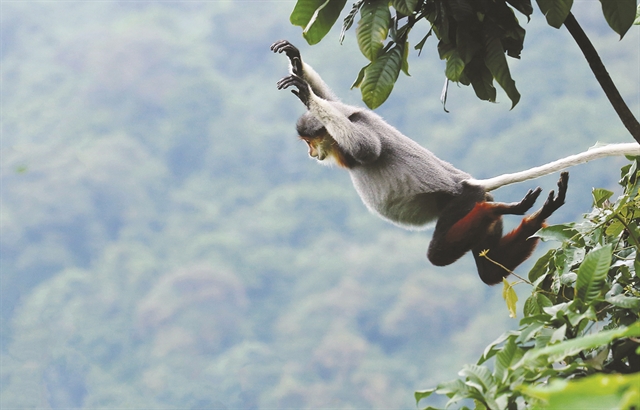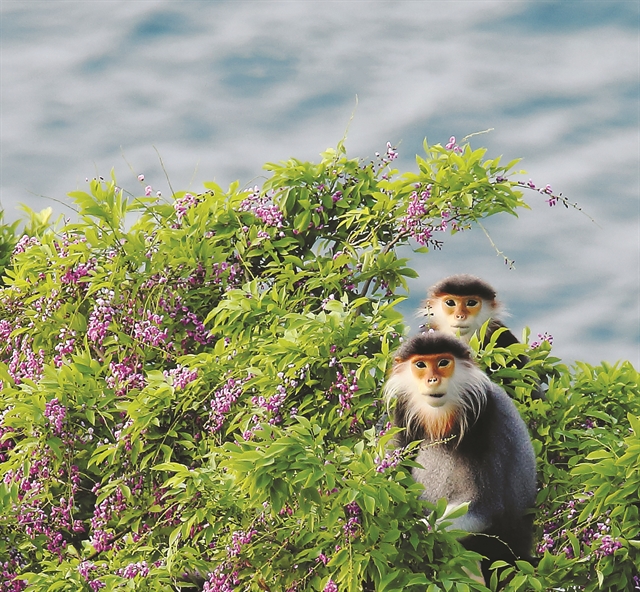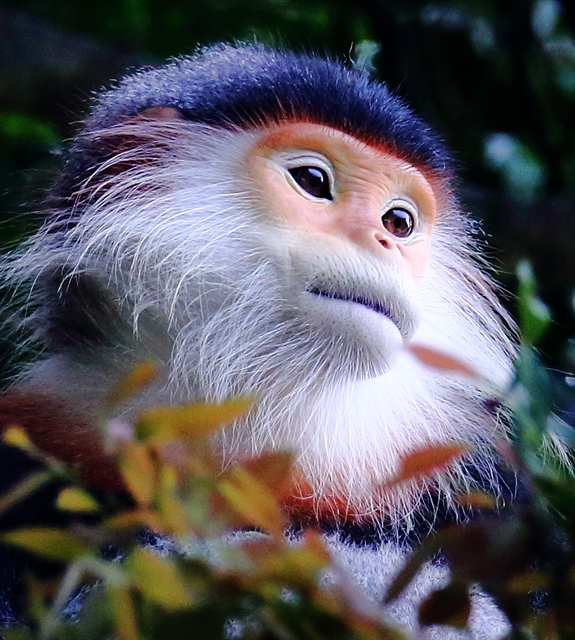.jpg)
Red-shanked doucs are on the Red List of Threatened Species by the International Union for Conservation of Nature (IUCN).
Since November 2017 I often come to visit Sơn Trà Nature Reserve in Đà Nẵng. There, in the forest’s green lungs, I made friends with the red-shanked doucs, one among 287 species of fauna at Sơn Trà.
Doucs are native to Southeast Asia. With their five-colour coats, they stand out from the great family of primates around the world. And so, they are dubbed "queen of primates".
Photographers love red-shanked doucs because of their colours. With time, the colours of a douc transform and become complete. Doucs under eight months have a blackish-blue face, pale chestnut body, gray tail, and black arms and feet. As a young adult from eight months to three years, doucs gradually adopt their five-colour coat: pink face, black head, hands and feet, gray body, white arms and tail. Most outstanding is their reddish-brown legs from the knee to the foot.

Red-shanked doucs live in groups. The smallest unit is a family with a male, a female and a few infants.
The current population of doucs at Sơn Trà numbers about 1,300 and zoologists say they have the most beautiful colours of their species.
A young douc performing this jump on its own is a sign that it is independent. Adult red-shanked doucs can jump as far as seven metres, proof of their strength and acrobatic finesse.
When I look back at my photos of doucs frozen in flight, I am always reminded of this “mid-air dance”. Powerful arms help doucs move easily through the forest by swinging from branch to branch as they jump from tree to tree.
I eagerly snap images whenever I see infant red-shanked doucs, creatures both innocent and mischievous. I am moved by the presence of infant doucs for another reason: Red-shanked doucs are on the Red List of Threatened Species by the International Union for Conservation of Nature (IUCN). So, infant red-shanked doucs give hope for the future of this rare primate species.
I have shot quite a lot of pictures of the leading doucs because I had to face them before I could approach the other members of their families. Red-shanked doucs live in groups. The smallest unit is a family with a male, a female, and a few infants. A male living with many females can have up to twenty members. Each family has a male leader. He guards the other members as they eat and play, and alerts them when danger is near. He also helps his mate to rear their children.
Other groups comprise several small families with blood relations. Each group has its own territory and does not enter that of its neighbours.

A young red-shanked douc performing this jump on its own is a sign that it is independent. Adult red-shanked doucs can jump as far as 20 feet, proof of their strength and acrobatic finesse.
Red-shanked doucs eat almost constantly, though they are not a gluttonous species. On the contrary, they are quite fussy about what they eat. Among the more than 1,000 species of plants at Sơn Trà, only about 150 species are consumed by doucs.
According to zoologists, their diet comprises 88 per cent leaves, 10 per cent fruits and seeds, 1.5 per cent flowers, and less than 1 per cent bark/pith.
Staple plants of red-shanked doucs at Sơn Trà include parashorea, crepe-myrtle, morning glory, garcinia, ficus, and ancistrocladus.
Such a menu barely provides enough nutrition, which is why they must eat throughout the day.
At institutes in Việt Nam and around the world, many scientific works and papers are dedicated to researching red-shanked doucs at Sơn Trà.
In addition to the IUCN and the Douc Langur Foundation (USA), there is the NGO GreenViet based in Đà Nẵng. Since 2012, GreenViet has led a movement to protect this rare primate species. — VNS

Every day, on their way to find food in the forest, red-shanked doucs jump from tree to tree, even as they hold their infants. This creates one of the most spectacular scenes of the forest. VNS Photo Vĩnh Quyền

Every day, on their way to find food in the forest, red-shanked doucs jump from tree to tree, even as they hold their infants. This creates one of the most spectacular scenes of the forest. VNS Photo Vĩnh Quyền